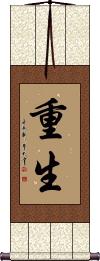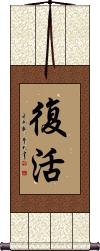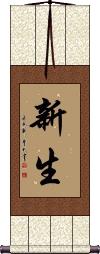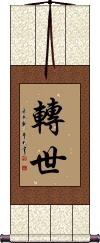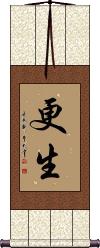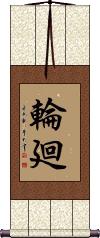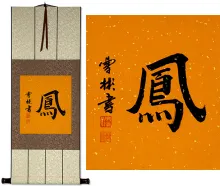Many custom options...
And formats...

Reborn in Chinese / Japanese...
Buy a Reborn calligraphy wall scroll here!
Personalize your custom “Reborn” project by clicking the button next to your favorite “Reborn” title below...
Re-Birth / Renaissance
重生 is the Chinese word for rebirth. This can be used literally or metaphorically. As a metaphor, you could use this to say something like, “We are watching the rebirth of New Orleans after the disaster of Katrina.”
重生 is sometimes translated as “renaissance.”
Note: 重生 is not the Buddhist concept of reincarnation or re-birth.
See Also: Reincarnation
Resurrection / Re-Birth
復活 is the Chinese, Japanese and Korean word for resurrection or rebirth.
復活 literally means “return to life.”
It is the term used in most Asian Bibles to refer to the resurrection of Christ. In Japanese, it is sometimes used to mean a Christian Revival. In some contexts, it can mean resuscitation.
See Also: Christianity | Jesus Christ | God of Abraham
New Life
新生 literally means “new life” or “new birth” in Chinese, Japanese Kanji, and old Korean Hanja.
Depending on the context, this word can also mean newborn, new student, rebirth, new birth, or nascent.
In Japanese, this can be the given name Wakaki.
Note: This is not the most common word selection for a calligraphy wall scroll. But if you’re a westerner, you can bend the rules a bit.
Reincarnation (Buddhism)
轉世 is the Buddhist idea of reincarnation or transmigration.
Other definitions of this term: “Attainer of Nirvana from within the desire realm,” “A practitioner who enters directly into Nirvana from the desire realm, without traversing the form and formless realms. One of the 27 kinds of Hinayana sages,” or simply, “to return again to this life.”
轉世 is also a Japanese title, but the first Kanji was slightly simplified after WWII. Just let us know if you want the modern Japanese version when you order.
Phoenix Rise from the Ashes
鳳凰涅磐 is a proverb that suggests “Legendary Phoenix rises from the ashes.” It means “Legendary Phoenix [reaches] Nirvana.”
There is a legend in China of a great bird reborn once every 500 years. This bird gathers all the ill will, suffering, desire, and other negative things of the world. The bird then plunges into the fire to burn away all negative things, sacrificing itself in the process (achieving Nirvana, or perhaps allowing others the opportunity to reach Nirvana).
500 years later, the phoenix is reborn from the ashes again, and the cycle repeats.
Rehabilitation / Rebirth
This is a Chinese, Korean and Japanese word that means rebirth or resurrection.
Other definitions include reinvigorated, rejuvenated, a new lease of life, rehabilitation, remaking one's life, starting life anew, regeneration, reorganization, rebuilding, recovery, restoration, remaking, coming back to life, revival, or resuscitation.
Samsara / Endless Cycle of Rebirth
輪廻 is one of a few ways to express संसार or Saṃsāra in Chinese, Japanese, and old Korean.
The Buddhist term can be translated in several ways, including:
An endless cycle of death and rebirth.
The turning of the wheel.
To revolve.
Transmigration in six ways.
The wheel of transmigration.
The round of existence.
This in-stock artwork might be what you are looking for, and ships right away...
Not the results for reborn that you were looking for?
Below are some entries from our dictionary that may match your reborn search...
| Characters If shown, 2nd row is Simp. Chinese |
Pronunciation Romanization |
Simple Dictionary Definition |
四種死生 四种死生 see styles |
sì zhǒng sǐ shēng si4 zhong3 si3 sheng1 ssu chung ssu sheng shi shu shishō |
Four kinds of rebirth dependent on present deeds: from obscurity and poverty to be reborn in the same condition; from obscurity and poverty to be reborn in light and honour; from light and honour to be reborn in obscurity and poverty; from light and honour to be reborn in the heavens. |
還生 还生 see styles |
huán shēng huan2 sheng1 huan sheng genshō |
To return to life; to be reborn in this world; to be reborn from the Hīnayāna nirvana in order to be able to attain to Mahāyāna buddhahood; also, restoration to the order, after repentance for sin. |
一切衆生喜見佛 一切众生喜见佛 see styles |
yī qiè zhòng shēng xǐ jiàn fó yi1 qie4 zhong4 sheng1 xi3 jian4 fo2 i ch`ieh chung sheng hsi chien fo i chieh chung sheng hsi chien fo Issai shujō kiken butsu |
Sarvasattva-priya-darśana. The Buddha at whose appearance all beings rejoice. (1) A fabulous Bodhisattva who destroyed himself by fire and when reborn burned both arms to cinders, an act described in the Lotus Sūtra as the highest form of sacrifice. Reborn as Bhaiṣajyarāja 藥王. (2) The name under which Buddha's aunt, Mahāprajāpatī, is to be reborn as Buddha. |
往生 see styles |
wǎng shēng wang3 sheng1 wang sheng oujou / ojo おうじょう |
to be reborn; to live in paradise (Buddhism); to die; (after) one's death (n,vs,vi) (1) {Buddh} passing on to the next life; (n,vs,vi) (2) death; (n,vs,vi) (3) giving up a struggle; submission; (n,vs,vi) (4) being at one's wits' end; being flummoxed; (5) (rare) (See 圧状・2) coercion The future life, the life to which anyone is going; to go to be born in the Pure Land of Amitābha. (1) 往相囘向 To transfer one's merits to all beings that they may attain the Pure Land of Amitābha. (2) 還相囘向 Having been born in the Pure Land to return to mortality and by one's merits to bring mortals to the Pure Land. |
戒善 see styles |
jiè shàn jie4 shan4 chieh shan kaizen |
The good root of keeping the commandments, from which springs the power for one who keeps the five to be reborn as a man; or for one who keeps the ten to be reborn in the heavens, or as a king. |
閻魔 阎魔 see styles |
yán mó yan2 mo2 yen mo enma えんま |
(Buddhism) Yama, the King of Hell {Buddh} Yama (King of Hell who judges the dead); Enma; (dei) Yama (king of the world of the dead, who judges the dead); Emma; Yan; Yomna 閻王 閻羅; (閻魔王); 閻摩羅; 閻老 Yama, also v. 夜; 閻羅王 Yama. (1) In the Vedas the god of the dead, with whom the spirits of the departed dwell. He was son of the Sun and had a twin sister Yamī or Yamuna. By some they were looked upon as the first human pair. (2) In later Brahmanic mythology, one of the eight Lokapālas, guardian of the South and ruler of the Yamadevaloka and judge of the dead. (3) In Buddhist mythology, the regent of the Nārakas, residing south of Jambudvīpa, outside of the Cakravālas, in a palace of copper and iron. Originally he is described as a king of Vaiśālī, who, when engaged in a bloody war, wished he were master of hell, and was accordingly reborn as Yama in hell together with his eighteen generals and his army of 80,000 men, who now serve him in purgatory. His sister Yamī deals with female culprits. Three times in every twenty-four hours demon pours into Yama's mouth boiling copper (by way of punishment), his subordinates receiving the same dose at the same time, until their sins are expiated, when he will be reborn as Samantarāja 普王. In China he rules the fifth court of purgatory. In some sources he is spoken of as ruling the eighteen judges of purgatory. |
僧寶果 僧宝果 see styles |
sēng bǎo guǒ seng1 bao3 guo3 seng pao kuo sōhō ka |
The perfect arhat who has not to be reborn. |
懈慢國 懈慢国 see styles |
xiè màn guó xie4 man4 guo2 hsieh man kuo keman koku |
懈慢界 A country that lies between this world and the Western Paradise, in which those who are reborn become slothful and proud, and have no desire to be reborn in Paradise. |
驗生人中 验生人中 see styles |
yàn shēng rén zhōng yan4 sheng1 ren2 zhong1 yen sheng jen chung |
An inquiry into the mode of a person's death, to judge whether he will be reborn as a man, and so on with the other possible destinies, e.g. 驗生地獄 whether he will be reborn in the hells. |
禪 禅 see styles |
shàn shan4 shan yuzuri ゆずり |
More info & calligraphy: Zen / Chan / Meditation(out-dated kanji) (1) (Buddhist term) dhyana (profound meditation); (2) (abbreviation) Zen (Buddhism); (surname) Yuzuri To level a place for an altar, to sacrifice to the hills and fountains; to abdicate. Adopted by Buddhists for dhyāna, 禪 or 禪那, i.e. meditation, abstraction, trance. dhyāna is 'meditation, thought, reflection, especially profound and abstract religious contemplation'. M.W. It was intp. as 'getting rid of evil', etc., later as 靜慮 quiet meditation. It is a form of 定, but that word is more closely allied with samādhi, cf. 禪定. The term also connotes Buddhism and Buddhist things in general, but has special application to the 禪宗 q.v. It is one of the six pāramitās, cf. 波. There are numerous methods and subjects of meditation. The eighteen brahmalokas are divided into four dhyāna regions 'corresponding to certain frames of mind where individuals might be reborn in strict accordance with their spiritual state'. The first three are the first dhyāna, the second three the second dhyāna, the third three the third dhyāna, and the remaining nine the fourth dhyāna. See Eitel. According to Childers' Pali Dictionary, 'The four jhānas are four stages of mystic meditation, whereby the believer's mind is purged from all earthly emotions, and detached as it were from his body, which remains plunged in a profound trance.' Seated cross-legged, the practiser 'concentrates his mind upon a single thought. Gradually his soul becomes filled with a supernatural ecstasy and serenity', his mind still reasoning: this is the first jhāna. Concentrating his mind on the same subject, he frees it from reasoning, the ecstasy and serenity remaining, which is the second jhāna. Then he divests himself of ecstasy, reaching the third stage of serenity. Lastly, in the fourth stage the mind becomes indifferent to all emotions, being exalted above them and purified. There are differences in the Mahāyāna methods, but similarity of aim. |
地獄 地狱 see styles |
dì yù di4 yu4 ti yü jigoku じごく |
More info & calligraphy: Hell(1) {Buddh} hell realm; Naraka; (2) {Christn} Hell; (3) hell; misery; nightmare; inferno; (4) place where a volcano or hot springs constantly spew smoke or steam; (place-name) Jigoku naraka, 捺落迦 (or 那落迦) ; niraya 泥犂; explained by 不樂 joyless; 可厭 disgusting, hateful; 苦具, 苦器 means of suffering; if 地獄 earth-prison; 冥府 the shades, or departments of darkness. Earth-prison is generally intp. as hell or the hells; it may also be termed purgatory; one of the six gati or ways of transmigration. The hells are divided into three classes: I. Central, or radical, 根本地獄 consisting of (1) The eight hot hells. These were the original hells of primitive Buddhism, and are supposed to be located umder the southern continent Jambudvīpa 瞻部州, 500 yojanas below the surface. (a) 等活 or 更活 Saṃjīva, rebirth, where after many kinds of suffering a cold wind blows over the soul and returns it to this life as it was before, hence the name 等活. (b) 黑繩 Kaslasūtra, where the sufferer is bound with black chains and chopped or sawn asunder. (c) 線合; 衆合; 堆壓 Saṃghāta, where are multitudes of implements of torture, or the falling of mountains upon the sufferer. (d) 號呌; 呼呼; 叫喚 Raurava, hell of wailing. (e) 大呌; 大號呌; 大呼 Mahāraurava, hell of great wailing. (f) 炎熱; 燒炙 Tapana, hell of fames and burning. (g) 大熱; 大燒炙; 大炎熱 Pratāpana, hell of molten lead. (h) 無間; 河鼻旨; 阿惟越致; 阿毗至; 阿鼻; 阿毗 Avīci, unintermitted suffering, where sinners die and are reborn to suffer without interval. (2) The eight cold hells 八寒地獄. (a) 頞浮陀地獄 Arbuda, where the cold causes blisters. (b) 尼刺部陀 Nirarbuda, colder still causing the blisters to burst. (c) 頞哳吒; 阿吒吒 Atata, where this is the only possible sound from frozen lips. (d) 臛臛婆; 阿波波 Hahava or Apapa, where it is so cold that only this sound can be uttered. (e) 虎虎婆 Hāhādhara or Huhuva, where only this sound can be uttered. (f) 嗢鉢羅; 鬱鉢羅 (or 優鉢羅) Utpala, or 尼羅鳥 (or 漚) 鉢羅 Nīlotpala, where the skin is frozen like blue lotus buds. (g) 鉢特摩 Padma, where the skin is frozen and bursts open like red lotus buds. (h) 摩訶鉢特摩 Mahāpadma, ditto like great red lotus buds. Somewhat different names are also given. Cf. 倶舍論 8; 智度論 16; 涅槃經 11. II. The secondary hells are called 近邊地獄 adjacent hells or 十六遊增 each of its four sides, opening from each such door are four adjacent hells, in all sixteen; thus with the original eight there are 136. A list of eighteen hells is given in the 十八泥梨經. III. A third class is called the 孤地獄 (獨地獄) Lokāntarika, or isolated hells in mountains, deserts, below the earth and above it. Eitel says in regard to the eight hot hells that they range 'one beneath the other in tiers which begin at a depth of 11,900 yojanas and reach to a depth of 40,000 yojanas'. The cold hells are under 'the two Tchahavālas and range shaft-like one below the other, but so that this shaft is gradually widening to the fourth hell and then narrowing itself again so that the first and last hell have the shortest, those in the centre the longest diameter'. 'Every universe has the same number of hells, ' but 'the northern continent has no hell whatever, the two continents east and west of Meru have only small Lokāntarika hells... whilst all the other hells are required for the inhabitants of the southern continent '. It may be noted that the purpose of these hells is definitely punitive, as well as purgatorial. Yama is the judge and ruler, assisted by eighteen officers and a host of demons, who order or administer the various degrees of torture. 'His sister performs the same duties with regard to female criminals, ' and it may be mentioned that the Chinese have added the 血盆池 Lake of the bloody bath, or 'placenta tank' for women who die in childbirth. Release from the hells is in the power of the monks by tantric means. |
永生 see styles |
yǒng shēng yong3 sheng1 yung sheng eisei / ese えいせい |
More info & calligraphy: Eternal Life / Everlasting Life / Immortalityeternal life; immortality; (personal name) Hisaki Eternal life; immortality; nirvana is defined as 不生 not being born, i. e. not reborn, and therefore 不滅 not dying; 永生 is also perpetual life; the Amitābha cult says in the Pure Land. |
老子 see styles |
lǎo zi lao3 zi5 lao tzu roushi / roshi ろうし |
More info & calligraphy: Lao Tzu / LaoziLaozi; Lao Tzu; Lao Tse; (person) Laozi (semi-legendary Chinese philosopher and deity); Lao Tzu; Lao Tse Laozi, or Laocius, the accepted founder of the Daoists. The theory that his soul went to India and was reborn as the Buddha is found in the 齊書 History of the Qi dynasty 顧歡傳. |
輪廻 轮廻 see styles |
lún huí lun2 hui2 lun hui rinne りんね |
More info & calligraphy: Samsara / Endless Cycle of Rebirth輪轉 saṃsāra, the turning of the wheel, to revolve, i.e. transmigration in the six ways, the wheel of transmigration; the round of existence. |
重生 see styles |
chóng shēng chong2 sheng1 ch`ung sheng chung sheng shigeo しげお |
More info & calligraphy: Re-Birth / Renaissance(given name) Shigeo |
戒 see styles |
jiè jie4 chieh kai; ingoto(ok) かい; いんごと(ok) |
to guard against; to exhort; to admonish or warn; to give up or stop doing something; Buddhist monastic discipline; ring (for a finger) (1) (かい only) {Buddh} admonition; commandment; (2) sila (precept) śīla, 尸羅. Precept, command, prohibition, discipline, rule; morality. It is applied to the five, eight, ten, 250, and other commandments. The five are: (1) not to kill; (2 ) not to steal; (3) not to commit adultery; (4) not to speak falsely; (5) not to drink wine. These are the commands for lay disciples; those who observe them will be reborn in the human realm. The Sarvāstivādins did not sanction the observance of a limited selection from them as did the 成實宗 Satyasiddhi school. Each of the five precepts has five guardian spirits, in all twenty-five, 五戒二十五神. The eight for lay disciples are the above five together with Nos. 7, 8, and 9 of the following; the ten commands for the ordained, monks and nuns, are the above five with the following: (6) not to use adornments of flowers, nor perfumes; (7) not to perform as an actor, juggler, acrobat, or go to watch and hear them; (8) not to sit on elevated, broad, and large divans (or beds); (9) not to eat except in regulation hours; (10) not to possess money, gold or silver, or precious things. The 具足戒full commands for a monk number 250, those for a nun are 348, commonly called 500. Śīla is also the first of the 五分法身, i.e. a condition above all moral error. The Sutra of Brahma's Net has the following after the first five: (6) not to speak of the sins of those in orders; (7) not to vaunt self and depreciate others; (8) not to be avaricious; (9) not to be angry; (10) not to slander the triratna. |
蘇 苏 see styles |
sū su1 su sohou / soho そほう |
Perilla frutescens (Chinese basil or wild red basil); place name; to revive; used as phonetic in transliteration (1) condensed milk; (n,n-suf,n-pref) (2) (abbreviation) Soviet Union; (personal name) Sohou Refreshing thyme; revive, cheer; Suzhou; translit. su, so, sa, s. Most frequently it translit. the Sanskait su, which means good, well excellent, very. Cf. 須, 修. |
上生 see styles |
shàng shēng shang4 sheng1 shang sheng wabu わぶ |
(place-name) Wabu be reborn into a superior state of existence |
不生 see styles |
bù shēng bu4 sheng1 pu sheng fushou / fusho ふしょう |
(place-name) Fushou anutpatti; anutpāda. Non-birth: not to be reborn, exempt from rebirth; arhan is mistakenly interpreted as 'not born', meaning not born again into mortal worlds. The 'nir' in nirvana is also erroneously said to mean 'not born'; certain schools say that nothing ever has been born, or created, for all is eternal. The Shingon word 'a' is interpreted as symbolizing the uncreated. The unborn or uncreated is a name for the Tathāgata, who is not born, but eternal ; hence by implication the term means "eternal". ādi, which means"at first, " "beginning","primary", is also interpreted as 不生 uncreated. |
中陰 中阴 see styles |
zhōng yīn zhong1 yin1 chung yin chuuin / chuin ちゅういん |
{Buddh} bardo; state (or period) of intermediate existence between one's death and rebirth (in Japan, 49 days); (place-name) Nakakage The intermediate existence between death and reincarnation, a stage varying from seven to forty-nine days, when the karma-body will certainly be reborn; v. 中有. |
了教 see styles |
liǎo jiào liao3 jiao4 liao chiao Ryōkyō |
A noted disciple named Ajñāta-Kauṇḍinya, v. 阿, also known as拘鄰鄰,了本際 and 知本際. He is described as "a prince of Magadha, maternal uncle of Śākyamuni, whose first disciple he became". He is "to be reborn as Buddha under the name of Samanṭa-Prabhāsa". Eitel. |
二業 二业 see styles |
èr yè er4 ye4 erh yeh nigyou / nigyo にぎょう |
(archaism) restaurants and geisha establishments Two classes of karma. (1) (a) 引業 leads to the 總報, i.e. the award as to the species into which one is to be born, e.g. men, gods, etc.; (6) 滿業 is the 別報 or fulfillment in detail, i.e. the kind or quality of being e.g. clever or stupid, happy or unhappy, etc. (2) (a) 善業 and (b) 惡業 Good and evil karma, resulting in happiness or misery. (3) (a) 助業 Aids to the karma of being reborn in Amitābha's Pure—land e. g. offerings, chantings, etc.; (b) 正業 thought and invocation of Amitābha with undivided mind, as the direct method. |
五性 see styles |
wǔ xìng wu3 xing4 wu hsing goshō |
The five different natures as grouped by the 法相宗 Dharmalakṣana sect; of these the first and second, while able to attain to non-return to mortality, are unable to reach Buddhahood; of the fourth some may, others may not reach it; the fifth will be reborn as devas or men: (1) śrāvakas for arhats; (2) pratyekabuddhas for pratyekabuddha-hood; (3) bodhisattvas for Buddhahood; (4) indefinite; (5) outsiders who have not the Buddha mind. The Sutra of Perfect Enlightenment 圓覺經 has another group, i. e. the natures of (1) ordinary good people; (2) śrāvakas and pratyekabuddhas; (3) bodhisattvas; (4) indefinite; (5) heretics. |
五果 see styles |
wǔ guǒ wu3 guo3 wu kuo goka ごか |
(1) five fruits (peach, Japanese plum, apricot, jujube, Japanese chestnut); (2) (Buddhist term) five types of effect in cause-and-effect relationships; (3) (Buddhist term) five effects of ignorance and formations on one's current life The five fruits, or effects; there are various groups, e. g. I. (1) 異熟果 fruit ripening divergently, e. g. pleasure and goodness are in different categories; present organs accord in pain or pleasure with their past good or evil deeds; (2) 等流果 fruit of the same order, e. g. goodness reborn from previous goodness; (3) 土用果 present position and function fruit, the rewards of moral merit in previous lives; (4) 增上果 superior fruit, or position arising from previous earnest endeavor and superior capacity: (5) 離繋果 fruit of freedom from all bonds, nirvana fruit. II. Fruit, or rebirth: (1) 識 conception (viewed psychologically); (2) 名色 formation mental and physical; (3) 六處 the six organs of perception complete; (4) 觸 their birth and contact with the world; (5) 受 consciousness. III. Five orders of fruit, with stones, pips, shells (as nuts), chaff-like (as pine seeds), and with pods. |
人因 see styles |
rén yīn ren2 yin1 jen yin ninin |
The causative influences for being reborn as a human being, i.e. a good life. Those in positions of honour have obtained them by former deeds of benevolence, reverence to Buddhas and monks, patience, humility, devotion to the sutras, charity, morality, zeal and exhortation, obedience, loyalty - hence they have obtained affluence, long life, and are held in high regard. Those in mean condition are thus born because of the opposite characteristics in previous incarnation. |
再生 see styles |
zài shēng zai4 sheng1 tsai sheng saisei / saise さいせい |
to be reborn; to regenerate; to be a second so-and-so (famous dead person); recycling; regeneration (n,vs,vt,vi) (1) restoration to life; coming to life again; resuscitation; regeneration; (n,vs,vi) (2) reformation; rehabilitation; (noun, transitive verb) (3) recycling; reclamation; recovery; (noun, transitive verb) (4) playback; regeneration (of video or sound); views (of an online video); (n,vs,vt,vi) (5) {biol} regeneration (of lost or damaged tissue); regrowth; (noun, transitive verb) (6) rebirth; reincarnation; (n,vs,vt,vi) (7) {psych} recall (memory); retrieval |
出現 出现 see styles |
chū xiàn chu1 xian4 ch`u hsien chu hsien shutsugen しゅつげん |
to appear; to arise; to emerge; to show up (n,vs,vi) appearance; emergence; advent; arrival; showing up; coming to existence To manifest, reveal, be manifested, appear, e. g. as does a Buddha's temporary body, or nirmāṇakāya. Name of Udāyi 優陀夷 a disciple of Buddha to be reborn as Samantaprabhāsa; also of a son of Ajātaśatru. |
受身 see styles |
shòu shēn shou4 shen1 shou shen jushin うけみ |
(n,adj-no,adj-na) (1) the defensive; (2) passive attitude; passivity; passiveness; (3) (linguistics terminology) the passive; passive voice; (4) (martial arts term) ukemi (the art of falling safely) to be reborn into a new body |
名相 see styles |
míng xiàng ming2 xiang4 ming hsiang myōsō |
famous prime minister (in ancient China); names and appearances (Buddhism) Name and appearance; everything has a name, e. g. sound, or has appearance, i. e. the visible, v. 名色; both are unreal and give rise to delusion. The name under which Subhūti will be reborn as Buddha. |
四土 see styles |
sì tǔ si4 tu3 ssu t`u ssu tu shido しど |
{Buddh} four realms (in Tendai Buddhism or Yogacara) The four Buddha-kṣetra, or realms, of Tiantai: (1) 凡聖居同土 Realms where all classes dwell— men, devas, Buddhas, disciples, non-disciples; it has two divisions, the impure, e. g. this world, and the pure, e. g. the 'Western' pure-land. (2) 方便有餘土 Temporary realms, where the occupants have got rid of the evils of 見思 unenlightened views and thoughts, but still have to be reborn. (3) 實報無障礙土 Realms of permanent reward and freedom, for those who have attained bodhisattva rank. (4) 常寂光土 Realm of eternal rest and light (i. e. wisdom) and of eternal spirit (dharmakāya), the abode of Buddhas; but in reality all the others are included in this, and are only separated for convenience, sake. |
Click here for more reborn results from our dictionary
The following table may be helpful for those studying Chinese or Japanese...
| Title | Characters | Romaji (Romanized Japanese) | Various forms of Romanized Chinese | |
| Re-Birth Renaissance | 重生 | chóng shēng chong2 sheng1 chong sheng chongsheng | ch`ung sheng chungsheng chung sheng |
|
| Resurrection Re-Birth | 復活 复活 | hukkatsu / hukatsu | fù huó / fu4 huo2 / fu huo / fuhuo | |
| New Life | 新生 | waka ki / wakaki | xīn shēng xin1 sheng1 xin sheng xinsheng | hsin sheng hsinsheng |
| Reincarnation (Buddhism) | 轉世 转世 | ten sei / tensei | zhuǎn shì zhuan3 shi4 zhuan shi zhuanshi | chuan shih chuanshih |
| Phoenix Rise from the Ashes | 鳳凰涅磐 凤凰涅磐 | fèng huáng niè pán feng4 huang2 nie4 pan2 feng huang nie pan fenghuangniepan | feng huang nieh p`an fenghuangniehpan feng huang nieh pan |
|
| Rehabilitation Rebirth | 更生 | kousei / kose kosei / kose | gēng shēng geng1 sheng1 geng sheng gengsheng | keng sheng kengsheng |
| Samsara Endless Cycle of Rebirth | 輪廻 轮廻 | rinne | lún huí / lun2 hui2 / lun hui / lunhui | |
| In some entries above you will see that characters have different versions above and below a line. In these cases, the characters above the line are Traditional Chinese, while the ones below are Simplified Chinese. | ||||
Successful Chinese Character and Japanese Kanji calligraphy searches within the last few hours...
